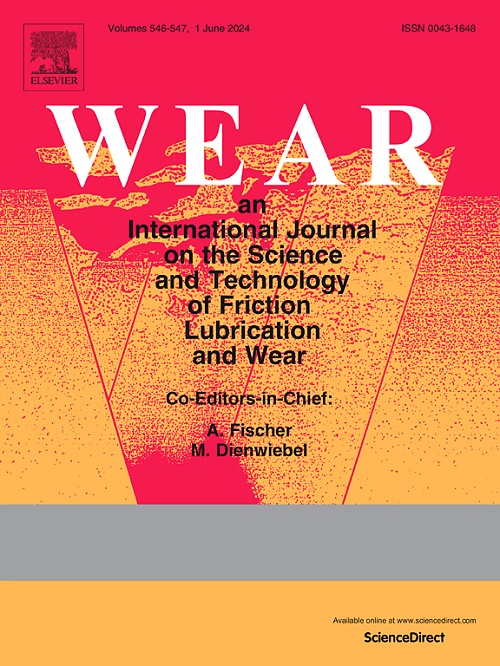Achieving an effective increase in wear resistance over a wide temperature range for Ti50Zr30Nb10Al10 refractory multi-principal element alloy: The introduction of a robust and deformable α2 phase
IF 5.3
1区 工程技术
Q1 ENGINEERING, MECHANICAL
引用次数: 0
Abstract
The limited wear resistance of multi-principal element alloys (RMPEAs) over a wide temperature range seriously restricts its further development and application. Though introducing a hard phase into the RMPEAs matrix is considered to be a common strategy to relief this contradiction, the brittleness of the hard phase and resulting heterogeneous interfaces often lead to unstable failure under prolonged wear conditions. In this work, a strong and deformable (Ti,Zr)3Al-type α2 phase was formed into Ti50Zr30Nb10Al10 RMPEAs through hot pressing and aging treatments to achieve robust wear performance over a wide temperature range, resulting in decreased wear rates and coefficient of friction of ∼50 % and ∼20 %, respectively. Based on the action of alternating frictional stress, multiple slip systems in the α2 phase are activated at room temperature. The good load-bearing and deformation capabilities of α2 phase are maintained up to 600 °C, thereby providing decreased wear rates form 17.3 × 10−4 mm3/Nm to 9.2 × 10−4 mm3/Nm. At higher temperatures (900 °C), the optimized alloy achieves the lowest wear rate of 0.6 × 10−4 mm3/Nm, which can be attributed to the Hall-Petch strengthening effect introduced by hot pressing and the protection of a dense oxide layer. These observations provide valuable insights for the design of superior wear-resistant RMPAs.

多主元素合金(RMPEAs)在宽温度范围内的有限耐磨性严重限制了其进一步发展和应用。虽然在 RMPEAs 基体中引入硬质相被认为是缓解这一矛盾的常用策略,但硬质相的脆性和由此产生的异质界面往往会导致在长期磨损条件下出现不稳定的失效。在这项工作中,通过热压和时效处理,在 Ti50Zr30Nb10Al10 RMPEAs 中形成了强韧且可变形的(Ti,Zr)3Al 型 α2 相,从而在宽温度范围内实现了稳健的磨损性能,使磨损率和摩擦系数分别降低了 ∼ 50 % 和 ∼ 20 %。在交变摩擦应力的作用下,α2 相中的多重滑移系统在室温下被激活。α2 相良好的承载和变形能力一直保持到 600 °C,从而使磨损率从 17.3 × 10-4 mm3/Nm 降至 9.2 × 10-4 mm3/Nm。在更高温度(900 °C)下,优化合金的磨损率最低,仅为 0.6 × 10-4 mm3/Nm,这可归因于热压引入的霍尔-佩奇强化效应以及致密氧化层的保护。这些观察结果为设计优异的耐磨损 RMPAs 提供了宝贵的启示。
本文章由计算机程序翻译,如有差异,请以英文原文为准。
求助全文
约1分钟内获得全文
求助全文
来源期刊

Wear
工程技术-材料科学:综合
CiteScore
8.80
自引率
8.00%
发文量
280
审稿时长
47 days
期刊介绍:
Wear journal is dedicated to the advancement of basic and applied knowledge concerning the nature of wear of materials. Broadly, topics of interest range from development of fundamental understanding of the mechanisms of wear to innovative solutions to practical engineering problems. Authors of experimental studies are expected to comment on the repeatability of the data, and whenever possible, conduct multiple measurements under similar testing conditions. Further, Wear embraces the highest standards of professional ethics, and the detection of matching content, either in written or graphical form, from other publications by the current authors or by others, may result in rejection.
 求助内容:
求助内容: 应助结果提醒方式:
应助结果提醒方式:


